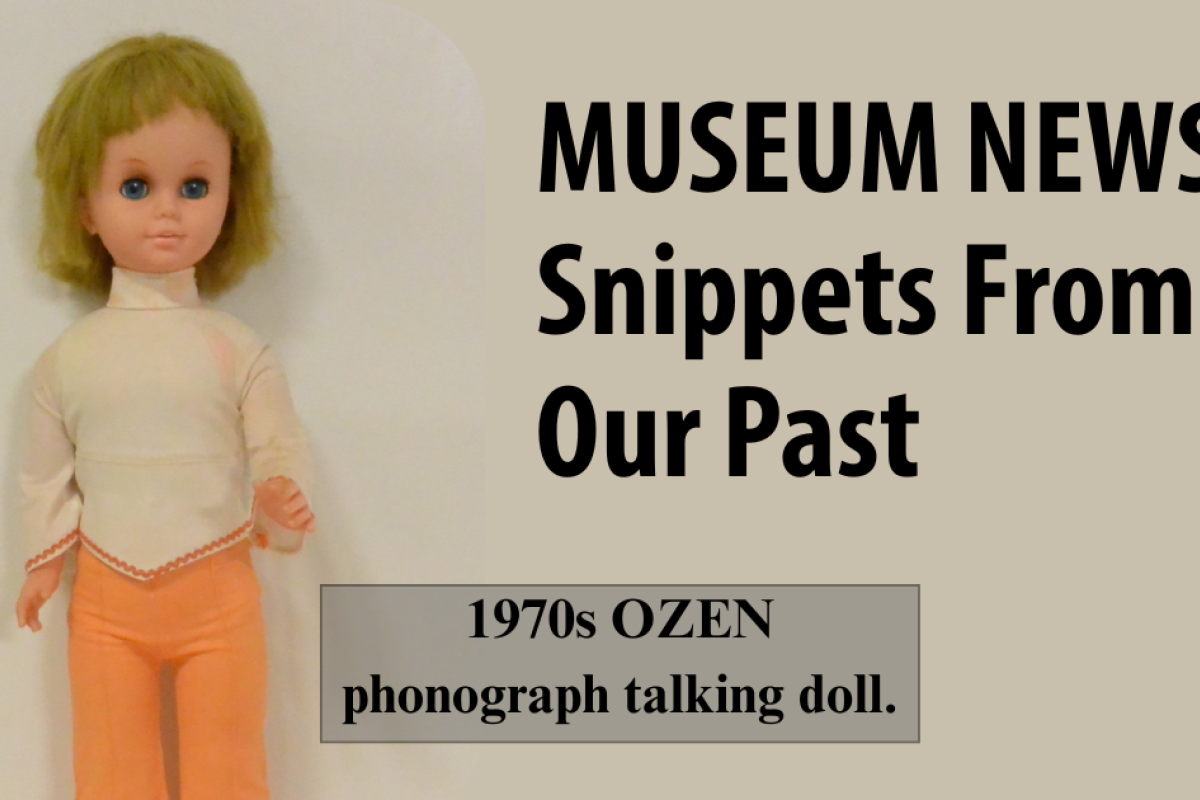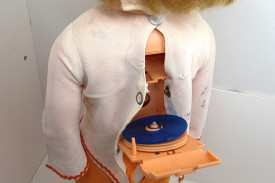General News
19 May, 2025
Museum news: Snippets From Our Past
We had a doll collector visit a couple of years ago who got quite excited about this particular doll. He had not seen one with the plastic records intact.

By Leonie Montogomery, museum coordinator
People often refer to the doll display as ‘creepy’. It even adds to the effect that as you enter the room the cabinet lights and a spotlight on the end cabinet come on. Suddenly all these eyes are looking at you. When I am at the museum, I am often working in the office and can hear when visitors enter the main display area, as the floor creaks. They often reach the doll room just as I appear to welcome them. They have been startled by the lights and then suddenly a voice from behind says “hello!”.
How much creepier would it be if it was the dolls who start talking?
‘Friends of the Phonograph’ have a website titled ‘Phonographia’, which presents a visual and popular culture history of the phonograph from 1877 to the present. It was from this site that I have sourced much of the following information.
As you know, the phonograph was invented by Thomas Edison. Apparently when Edison first thought about being able to record sound in July 1877, his initial thoughts were that it would be used for dictation. The site references Patrick Feaster, a specialist in the history, culture and preservation of sound media.
He reveals that on a brainstorming note dated November 23, Edison writes [sic] “I propose to apply the phonograph principle to make Dolls speak sing cry and make various sounds also apply it to all kinds of Toys such as Dogs animals, fowls, Reptiles, human figures: to cause them to make sounds to steam Toy Engine imitation of exhaust and whistle”. Note the lack of punctuation.
The magazine ‘Scientific American’ contained an article with illustrations in its April 26, 1890 edition about the manufacturing of Edison’s talking doll. There was also an advertisement from Schwarz’ Toy Bazaar, “Edison’s Phonographic Doll, the greatest wonder of the age. A French joined doll reciting in a childish voice of a number of well-known nursery rhymes. Size 22 inches. Price $10”.
The doll had a ceramic head, arms and legs and a metal body which housed the phonograph and cylinder. Holes in the chest acted as the speaker. A winder at the back powered the phonograph in a similar fashion to the normal phonograph.
The next doll referenced was the Mattel Chatty Cathy. This doll was introduced in 1960 and operated by means of a pull string. The 1960s is referred to as “the beginning of the Golden Age of Talking Toys. It was an era that saw the popularity of many dolls, characters figures, games, clocks and other toys that all had a ‘phonograph’ inside of them which play a disc record.’ I have spoken to many visitors who reminisce about having a Chatty Cathy doll when they were young.
The feature doll for this article contains an ‘OZEN’ device. This device was invented by Katsumi Watanabe of Japan. As with many inventions, the doll has patent numbers moulded all over the back. Katsumi applied for a patent with the US Patent office on March 1, 1968.The final patent was approved on June 29, 1971. Under the inventor’s name on the Patent was ‘No. 371, Ozenji, Kawasaki- shi, Japan’. This appears to be an address, which maybe where the Ozen name for the talking device originated.
The Ozen device was a battery powered record playing that was put inside an assortment of dolls and toys with its various phrases heard when a button was pressed. The description on the patent is “A toy phonograph having a rotatable turntable with a lifting cam in the centre of the turntable onto which a pivoted lifting arm travels at the end of a play of record to lift up a hinged overhanging loudspeaker to free a pivoted tone arm to return to the periphery of the turntable and also having a pressing mechanism to press the loudspeaker against the tone arm while playing .”
As sound systems changed, so did toys. In 1985 Teddy Ruxpin was introduced as a talking and animated toy using a cassette tape system and this was later replaced by digital recordings on chips becoming the voice of talking toys.
Our unnamed teenage talking doll is 600mm tall with short, straight, blonde hair. This may not be original, as our little owner may have done some hairstyling with scissors at some stage. She is wearing typical early seventies clothing of a skivvy and orange flared pants. We have three brightly coloured plastic records that are 60mm in diameter. One is red, another blue and the third colourless. We have not inserted batteries to know what words of wisdom or comfort our Ozen doll uttered some 50-years-ago.
Read More: Nyngan


